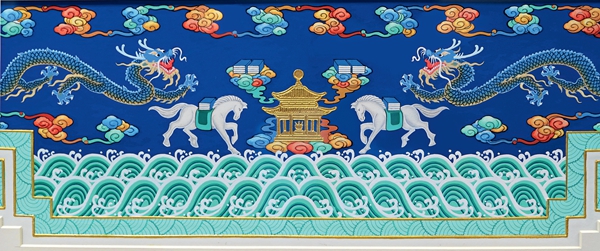Guardian of heritage of ancient Chinese architectual colored drawings
- By special correspondents Chen Heying & Pan Jianfang
 0 Comment(s)
0 Comment(s) Print
Print E-mail China Today, June 22, 2017
E-mail China Today, June 22, 2017
Colored drawings adorning traditional wooden structures in China are a decorative necessity. This artistic form is unique and distinct, representing some of the best oriental design.
A richly ornamented building is often admired for its carved beams and painted rafters. Exquisite paintings draw the visitor's eye away from the entire construction to the detailed decorations, their delicate patterns, thoughtful composition, and harmonious color tones. They convey the essence of Chinese culture, aesthetic spirit, and oriental philosophy.
Paintings on the Beams
Professor Li Sha from Beijing University of Civil Engineering and Architecture is a champion of the art of colored drawings. Whilst studying at Tianjin Academy of Fine Arts he was fascinated by the decorative effect of colored drawings on ancient buildings. In over 30 years of teaching, Professor Li has explored the integration between architecture and art. Architecture is a form of art, Professor Li says, so the two are interwoven and inseparable. He has made it his mission in life to protect the art of colored drawings and pass it on to the next generation.
|
Section of a Sushi style color painting by Professor Li Sha and Hou Qiyue. |
People originally applied paint to wooden constructions to protect the wood from damp, rot, and moths, thus prolonging the life of the architecture. Later, the focus shifted to decoration and as late as in the Song Dynasty (960-1279) colored drawings became a staple element of palace construction. The paintings, luxurious and elegant, all follow strict rules concerning their degree of decorativeness and amount of gold used according to status and function of the building. This coupling of aesthetics and functionality reflects traditional Chinese philosophy and ethics.
Official designers in the Qing Dynasty (1644-1911) developed a series of color painting techniques that were used in official architectures and varied in styles and themes: Hexi featured magnificence and bright colors; Xuanzi was known for grand and brisk paintings; and elegant Sushi paintings mimicked a style popular in eastern China. Some paintings had auspicious implications.
Passing Skills On
For centuries the techniques necessary for colored drawings have been passed down through apprenticeship. Apprentices learned while observing their masters' work and tried their hand at painting under guidance. In recent years, however, fewer people have taken up this profession, which has led to a shortage of skilled muralists.
 |
|
Professor Li Sha, pioneer of architectural colored drawing education. |
With few successors, the ancient art form could face extinction. According to Professor Li, this is not an exageration. He believes including the skills in the college curriculum, including the practicum, is important for passing them down. At present, architecture and art are different majors, with few teachers or students taking both into account. For example, fine arts academies usually have courses on murals, which, however, do not include this type of colorful decorative paintings on their syllabus. Architecture colleges have majors on historical architecture conservation, but their students, most of whom have an engineering background, lack the ability to design.
In an effort to integrate the two majors, Professor Li visited and learned from many experts in art education and veteran color painters. On the basis of his own teaching and research, he mastered the rules and each step of the design process. Thanks to Professor Li's long-time advocacy and efforts, Beijing University of Civil Engineering and Architecture adopted the decorative paintings found in ancient buildings in its undergraduate curriculum in 2014, marking it the first course of its kind. Art theory research is also under way in Professor Li's graduate class.
In his introductory lessons, Professor Li guides his students to paint simple patterns, such as flowers and clouds, to get a feel for traditional aesthetics and build confidence. Students then start to deal with more complex patterns like dragons and phoenixes.
Professor Li takes students to restored ancient buildings, such as the Donghua Gate of the Forbidden City, Xitian Fanjing (the Realm of Buddha) in Beihai Park, and the Baoguang Room in Prince Gong's Mansion. These field trips allow young students to see different classes and categories of decorative paintings. They also have the opportunity to sift gold powder and gild to develop a sense of color contrast and harmony.







Go to Forum >>0 Comment(s)